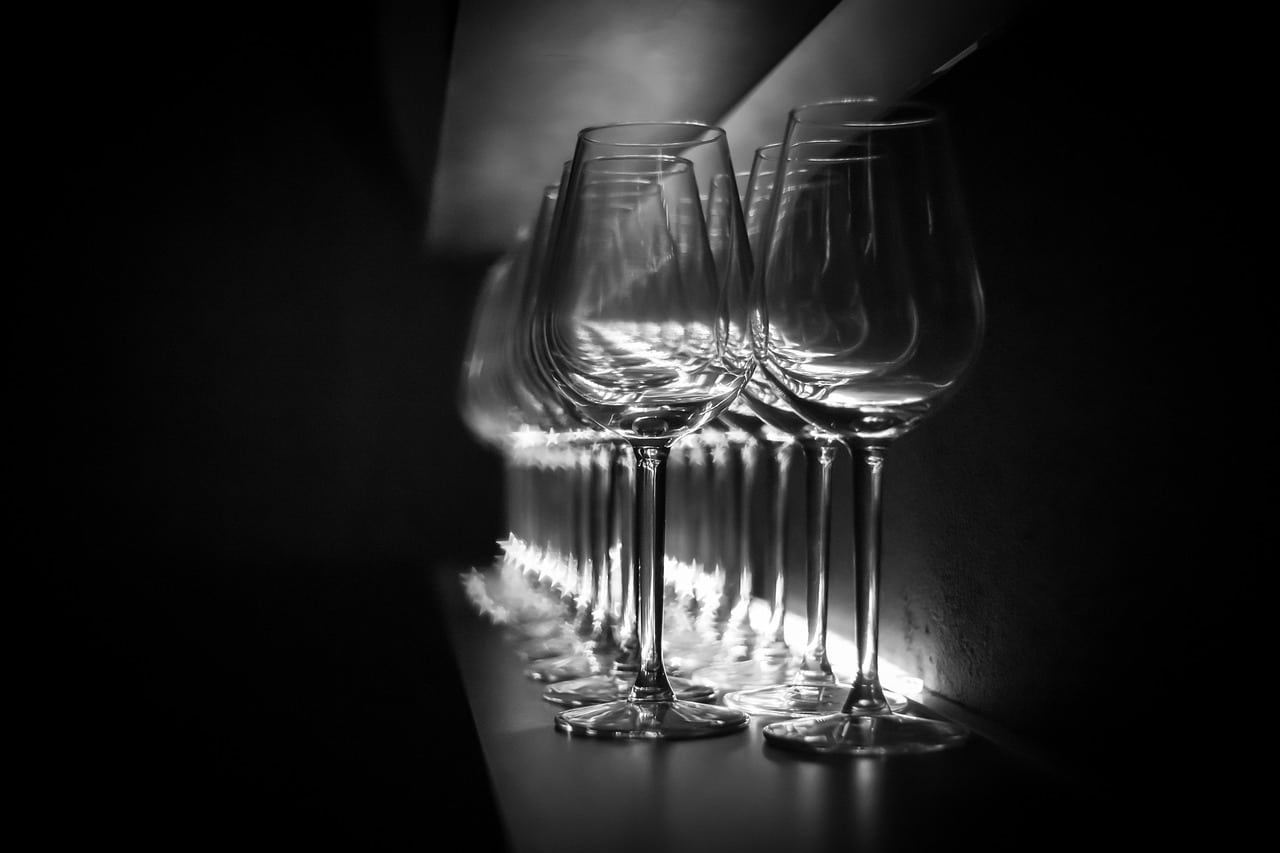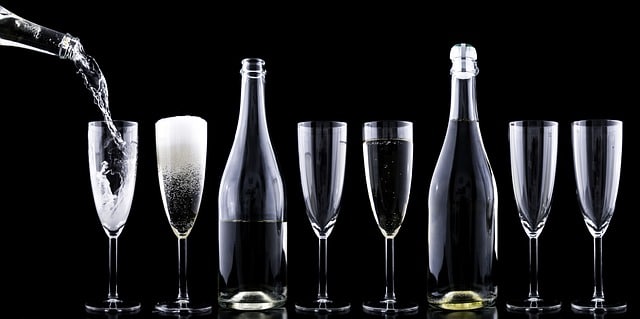Understanding the different types of champagne glasses can transform your drinking experience, preserving delicate bubbles while enhancing complex aromas. This guide explores flutes, tulips, and coupes – explaining how their unique shapes affect performance and ideal uses so you can pair the perfect glass with your occasion, serving style, and wine selection.
Champagne glasses and core types: tulip, coupe, flutes
The three primary champagne glass types – flute, tulip, and coupe – each offer distinct experiences shaped by their bowl design, rim width, and bubble behavior. While flutes showcase vertical sparkle, tulips balance aroma and effervescence, and coupes prioritize nostalgic charm over sustained carbonation.

What are the main champagne glass types
Flutes feature a tall, narrow bowl with a slender stem and tight opening, creating a stunning vertical bubble display while slowing CO₂ loss. The classic champagne flûte design makes it ideal for toasts and celebrations where maintaining effervescence is key.
Tulip champagne glasses combine the best features – their wider midsection tapers at the rim to concentrate aromas while preserving bubbles longer than coupes. This hybrid design makes tulip champagne glasses excellent for appreciating complex sparkling wines.
Coupes with their shallow, wide bowls suit retro-themed events and champagne cocktails nicely, though they’re less practical for maintaining carbonation during extended drinking.
How shape changes bubbles and aromas
The glass shape directly impacts your drinking experience: narrow flute rims trap carbonation, wide coupes lose bubbles quickly, while tulip champagne glasses strike a perfect balance. The tulip’s tapered rim channels aromas toward your nose, unlike the coupe’s open design that lets scents dissipate.
Well-crafted crystal champagne glasses often feature laser-etched nucleation points at the base to create steady, visually appealing bubble streams. Maintaining proper carbonation keeps the texture lively – when bubbles fade faster (as in coupes), the wine can taste sweeter and less vibrant.
Best single choice for home or bars
For versatile everyday use, tulip-shaped glasses or quality white wine glasses offer the best compromise between aroma appreciation and bubble retention. These work beautifully for various champagne styles, food pairings, and professional tastings while keeping the wine’s signature effervescence intact.
Traditional champagne flûtes remain essential for large events where maintaining maximum sparkle and preventing spills takes priority. While lead-free crystal champagne glasses enhance visual appeal, durable machine-made versions better withstand frequent washing in active bar environments.
Reserve coupes for special theme parties, champagne cocktails, or decorative displays where aesthetics outweigh functionality. Using a wine preservation system lets you compare different types of champagne glasses over several days without compromising quality – particularly helpful when evaluating how shape affects your drinking experience.
Choosing Flutes, Tulips, or Coupes for Wine
When selecting champagne glasses, the right shape enhances the drinking experience—whether you prefer the elegance of flutes, the aromatic focus of tulip glasses, or the vintage charm of a coupe. Each style serves a purpose: flutes highlight bubbles, tulips reveal nuanced aromas, and coupes bring classic flair to your serving.

Is Champagne Better in a Flute or Coupe?
A champagne flute preserves bubbles longer with its tall, narrow shape, making it ideal for formal toasts and parties. Meanwhile, a coupe champagne glass—wider and shallower—offers vintage appeal but lets carbonation escape faster. Your choice depends on whether you prioritize sparkle or style.
- Bubble longevity: Flutes keep carbonation lively, while coupes flatten quickly.
- Aroma diffusion: Flutes concentrate scents; coupes spread them widely.
- Practicality: Flutes are better for standing events, while coupes shine in seated service with garnishes.
- Occasions: Weddings favor flutes, while themed parties embrace coupes’retro look.
For best results, chill champagne glasses before serving. Since coupes expose more surface area, they warm faster, shortening the crisp carbonation experience.
When to Prefer a Tulip Over a Flute
The tulip shape merges the best of flutes and wine glasses. It retains bubbles better than a coupe while allowing deep aroma appreciation—ideal for complex or aged champagnes.
Serve around 12 cl at 8–10 °C in a chilled tulip glass. A gentle swirl unlocks the bouquet without losing effervescence, keeping the wine lively during tastings.
Save flutes for fresh, chilled champagne and reserve tulips for premium, aromatic selections where scent matters most.
What Are Old-Fashioned Champagne Glasses Called?
The coupe champagne glass, also known as a champagne saucer, traces back to the 1920s. Its wide, shallow bowl loses bubbles quickly but delivers unmatched vintage style.
Originally inspired by 17th-century cups, the coupe lost popularity as drinkers sought longer-lasting carbonation. Today, bartenders revive it for cocktails and themed events, embracing its nostalgic charm despite rapid bubble loss.
Serving Champagne Flutes Like a Pro
Pouring champagne like an expert starts with selecting the perfect glass—whether it’s elegant flutes, tulip-shaped bowls, or classic coupes—and handling it properly. The right glassware, combined with ideal serving temperature and careful pouring, keeps the bubbles lively, enhances the aroma, and highlights the craftsmanship of the sparkling wine for the best drinking experience.
Service Tips That Protect Bubbles and Aroma
Consider the occasion when choosing between champagne glass types. Sleek flutes work well for toasts and weddings, reducing spills while showcasing continuous bubbles. Tulip glasses intensify the aroma for seated tastings, while coupes bring vintage style to cocktail parties.
- Perfect serving temperature: Chill sparkling wine below 10°C, keep bottles in an ice-water mix between pours, and pre-chill glasses to maintain carbonation.
- Pouring method: Tilt the flute slightly or start with a small pour, then fill gently to prevent excess foam and preserve texture.
- Cleaning essentials: Avoid soap or residue that disrupts bubbles—rinse with hot water and buff with a microfiber cloth.
- Proper handling: Hold the stem, not the bowl, as stemless styles warm quickly and lose carbonation faster, sacrificing performance for durability.
Lightly swirl tulip or white wine glasses to release aromas without losing bubbles. In a champagne flute, avoid swirling to maintain the steady rise of bubbles—agitation breaks the stream and dulls the visual appeal.
Care and Buying Checks for Glassware
Lead-free crystal offers ultra-thin rims and brilliant clarity, enhancing both aroma and sparkle, while machine-made glasses provide durability and dishwasher safety for restaurants or everyday use. No matter which champagne glass you prefer, check the stem balance, rim thickness, and subtle etched marks that encourage bubble formation.
Don’t stack delicate glasses—store them upright to prevent chips that compromise both style and function. Hand-wash fine crystal with unscented detergent, use a light dishwasher cycle for sturdy glasses, and dry immediately with a lint-free cloth to maintain shine and ensure a flawless drinking experience.
Smart Preservation Solutions
With a pressure-preserving system, you can fully appreciate the wine’s aroma in a tulip glass or the mesmerizing bubbles in a flute, knowing effervescence stays fresh for nearly a week. This lets you compare vintage cuvées one day and brut styles the next, with no rush to finish opened bottles and zero loss in carbonation.
Store pressurized bottles upright below 10°C to keep pressure stable. Staff should inject a CO₂/N₂ mix for about five seconds per bottle—one cartridge preserves around five bottles—ensuring lasting bubbles and aroma whether served in tulip, flute, or coupe glasses. Learn how to keep Champagne fresh for days and explore how portable systems maintain carbonation while you experiment with different champagne glass types over time.
